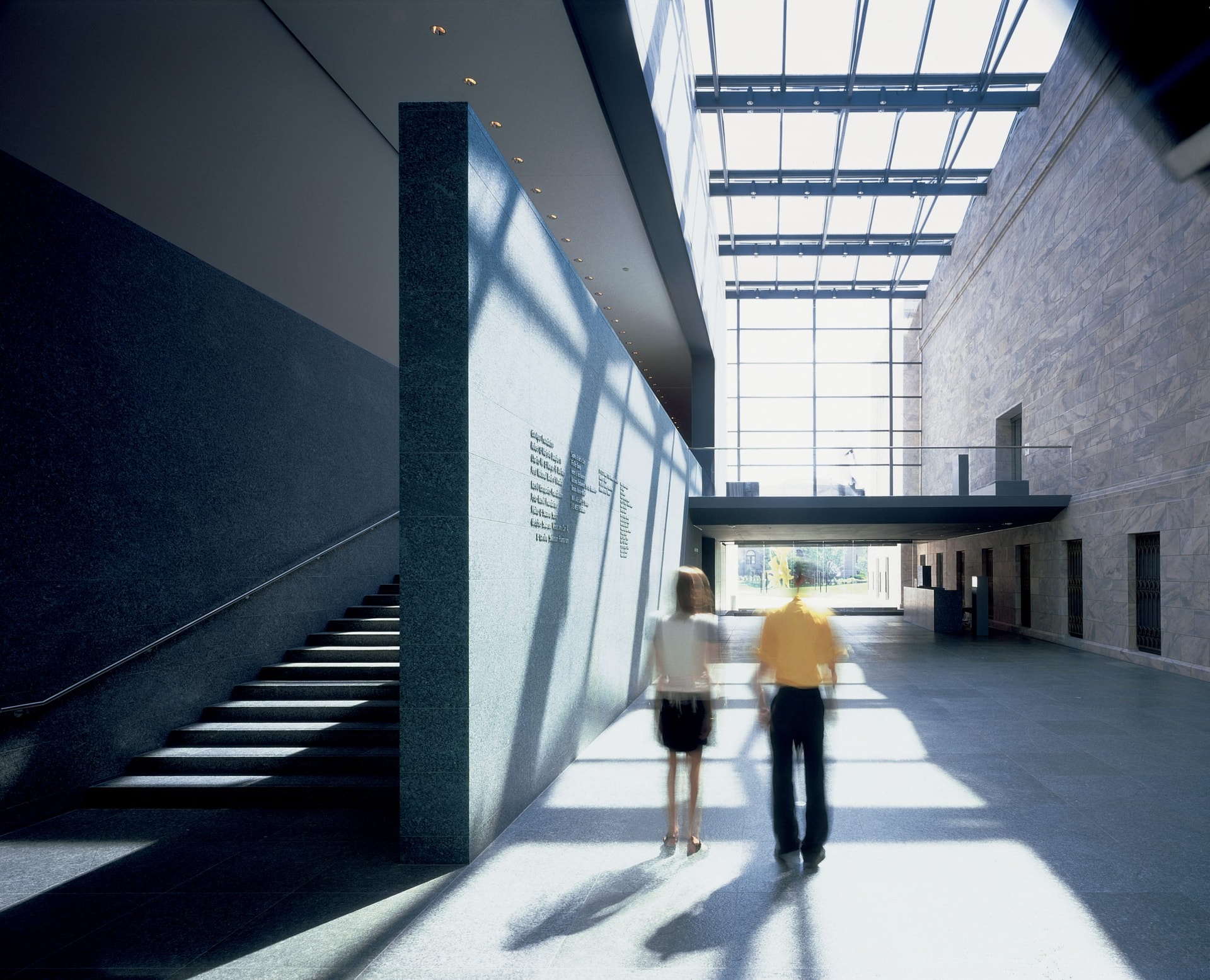Growth of the Museum | The Joslyn
The Beginning
The Joslyn Memorial opened to the public on November 29, 1931, under the auspices of the Society of Liberal Arts, a nonprofit corporation founded and privately funded by Sarah Joslyn. Gifts from individual collectors and from Omaha’s two main art societies, the Art Institute of Omaha and the Friends of Art, formed the basis of the Museum’s collection. The original 1931 Art Deco building, designed by the father–son architectural team of John and Alan McDonald, was hailed not only as an important addition to the city of Omaha, but to modern American architecture as well. In 1938 it was listed among the 100 finest buildings in the United States.
Pictured: Eugene Kingman (director 1947–69) oversees the delivery of art to the Joslyn Memorial

For many years, the Joslyn Memorial remained the focus of much cultural activity. Some of the best collections in the region were turned over to its care, and Dr. Paul Grummann, the first director, was able to make additional acquisitions—a substantial endowment bequeathed by Sarah Joslyn in 1940 supported the purchase of European Old Master paintings. In 1947 Grummann retired and was succeeded by the curator Eugene Kingman, who served as director until 1969. Under Kingman, the Joslyn Memorial embraced all aspects of human intellectual endeavor. All kinds of art and artifacts were displayed, including period rooms and a covered wagon. He envisioned a complex of buildings to include a science museum and a planetarium (these never came to fruition). He expanded the exhibition program to include such historically based exhibitions as Scrolls from the Wilderness of the Dead Sea—to this day, the highest attended exhibition in Museum history considering its time on view (85,000 visitors in just three weeks).

The First Expansion
From the 1970s until the late 1980s, aspects of the building were updated whenever possible, but a growing audience, art collection, and programming pointed to the need for additional galleries, public spaces, and modernized facilities. In 1987, Joslyn Art Museum was adopted as the institution’s legal name, and planning for a dramatic capital expansion began. Director Graham W. J. Beal noted “the need for a facility amenable to activities that are both serious and lively, intellectual and social . . . facilities that would convert the sixty-year-old, general-purpose cultural center into a specialist art museum, as well as provide the means to handle the retail and food service operations now common to most art museums of any size.” The Renowned British architect Norman Foster, now Baron Foster of Thames Bank, was selected to lead the project—his first US commission. His design—an elegant, rectilinear form connected to the original building by way of a soaring glass atrium—added 58,000 square feet to the Museum, including 14,000 square feet of gallery space to accommodate the Museum’s postwar and contemporary art collection and temporary exhibitions. The Suzanne & Walter Scott Pavilion opened to the public November 19, 1994.

In celebration of The Joslyn’s 75th anniversary, plans for two new sculpture gardens were announced by then director J. Brooks Joyner. Opened to the public on June 6, 2009, the Peter Kiewit Foundation Sculpture Garden added flowing water features, landscaped green spaces, and important sculptures by internationally renowned artists. October 31, 2009, marked the debut of the Dorothy & Stanley Truhlsen Discovery Garden, completing the transformation of the campus.

A New Joslyn
In 2010, The Joslyn’s current executive director & CEO, Jack Becker, arrived in Omaha. Spurred by a renewed commitment to free general Museum admission for all in 2013, The Joslyn’s annual attendance increased almost 60 percent from 2010 to 2019, when over 190,000 people from all 50 states and countries around the world visited the Museum. Demand for on-site learning and engagement and outreach opportunities has increased, as has programming with partners. The permanent collection has grown to include over 12,000 objects representing 5,000 years of human creativity and the world’s diverse cultures.
In October 2018, Joslyn leadership announced the third major capital project in the Museum’s history—a physical and programmatic expansion led by the Norwegian and American architectural firm Snøhetta. Designed in collaboration with Alley Poyner Macchietto Architecture, the 42,000-square-foot Rhonda & Howard Hawks Pavilion is the centerpiece of a project that creates a new visitor experience of The Joslyn and its grounds while expanding gallery space by more than 40 percent for a historic and growing collection. On July 27, 2021, ground was broken, and the Museum closed to the public on May 2, 2022, for the safety of people and art during construction and renovation.
The Joslyn reopened on September 10, 2024. Highlights at reopening include the first public presentation of new acquisitions from the renowned Phillip G. Schrager Collection, a works on paper gallery featuring selections from a gift to the Museum by Omaha-born artist Ed Ruscha, an exhibition featuring new work by Eva LeWitt, and a complete reinstallation of The Joslyn’s permanent collection.
Photograph © Nic Lehoux
